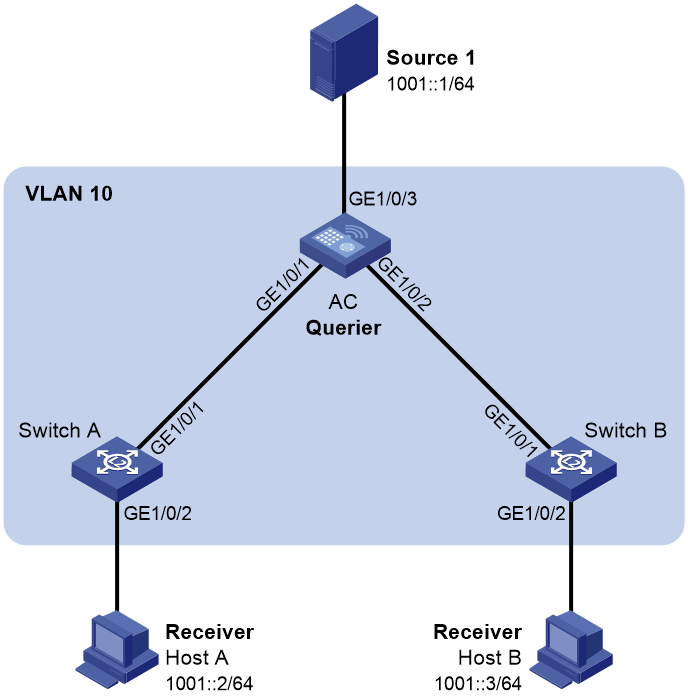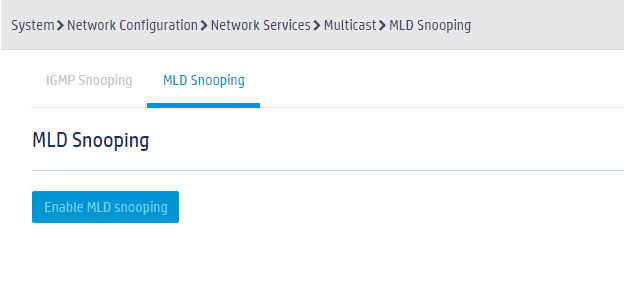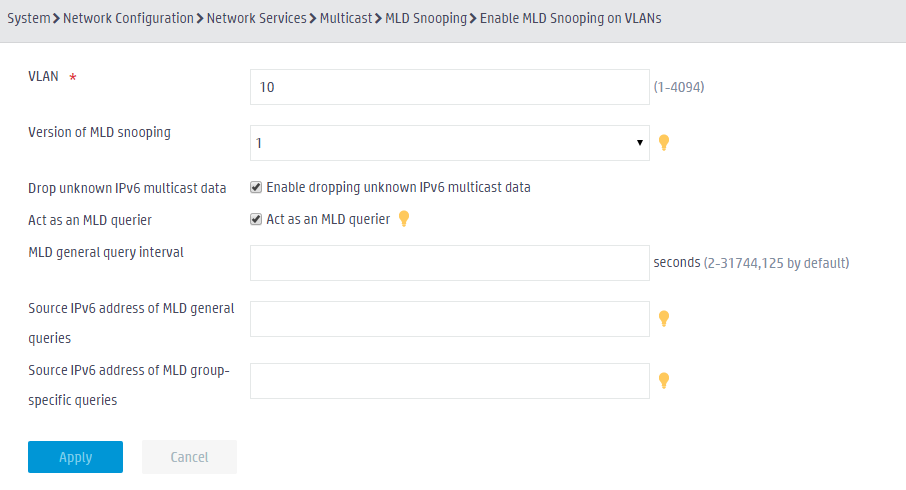- Table of Contents
-
- 03-Basic Network Configuration
- 01-Layer 2 Static Link Aggregation Configuration Example
- 02-Layer 2 Dynamic Link Aggregation Configuration Example
- 03-PPPoE Client Configuration Example
- 04-Static IPv6 Address Configuration Example
- 05-IPv6 Static Routing Configuration Example
- 06-Static IPv4 DNS Configuration Example
- 07-Static IPv6 DNS Configuration Example
- 08-Dynamic IPv4 DNS Configuration Example
- 09-Dynamic IPv6 DNS Configuration Example
- 10-IPv4 DNS Proxy Configuration Example
- 11-IPv6 DNS Proxy Configuration Example
- 12-Static NAT Configuration Example
- 13-Dynamic NAT Configuration Example
- 14-IPv4 ACL-Based Packet Filter Configuration Example
- 15-IPv6 ACL-Based Packet Filter Configuration Example
- 16-ARP Attack Protection Configuration Example
- 17-ARP Proxy Configuration Example
- 18-IGMP Snooping Configuration Example
- 19-MLD Snooping Configuration Example
- Related Documents
-
| Title | Size | Download |
|---|---|---|
| 19-MLD Snooping Configuration Example | 96.20 KB |
|
|
|
H3C Access Controllers |
|
Comware 7 MLD Snooping |
|
Configuration Example |
Copyright © 2024 New H3C Technologies Co., Ltd. All rights reserved.
No part of this manual may be reproduced or transmitted in any form or by any means without prior written consent of New H3C Technologies Co., Ltd.
Except for the trademarks of New H3C Technologies Co., Ltd., any trademarks that may be mentioned in this document are the property of their respective owners.
The information in this document is subject to change without notice.
Contents
Example: Configuring MLD snooping
Configuring the AC as an MLD querier
Configuring MLD snooping on switches
Overview
Prerequisites
The configuration examples were created and verified in a lab environment, and all the devices were started with the factory default configuration. When you are working on a live network, make sure you understand the potential impact of every command on your network.
The following information is provided based on the assumption that you have basic knowledge of MLD snooping.
Example: Configuring MLD snooping
Network configuration
As shown in Figure 1, Source 1 sends IPv6 multicast data to multicast group FF1E::101. Host A and Host B are receivers of multicast group FF1E::101 and run MLDv1.
Configure the AC as an MLD querier. To prevent IPv6 multicast packet from being flooded in VLAN 10, enable dropping unknown IPv6 multicast data on all devices.
Procedures
Configuring the AC as an MLD querier
1. Click the System View tab at the bottom of the page.
2. From the navigation pane, select Network Configuration > Network Services > Multicast.
3. Click the MLD Snooping tab.
4. Click Enable MLD snooping.
Figure 2 Enabling MLD snooping
5. On the page that opens, click the Add button ![]() .
.
6. Configure MLD snooping for VLAN 10:
a. Set the MLD snooping version to 1.
b. Enable dropping unknown IPv6 multicast data.
c. Enable MLD querier.
Figure 3 Configuring MLD snooping for VLAN 10
7. Click Apply.
Configuring MLD snooping on switches
On Switch A and Switch B, enable MLDv1 snooping and enable dropping unknown IPv6 multicast packets for VLAN 10.
Verifying the configuration
Verify that an MLD snooping forwarding entry is created for multicast group FF1E::101 after Host A or Host B joins the multicast group. (Details not shown.)
Related documentation
H3C Access Controllers Web-Based Configuration Guide




